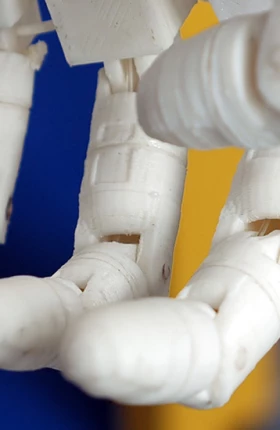Industrial production was transformed by steam power in the nineteenth century, electricity in the early twentieth century, and automation in the 1970s. These waves of technological advancement did not reduce overall employment, however. Although the number of manufacturing jobs decreased, new jobs emerged and the demand for new skills grew. Today, another workforce transformation is on the horizon as manufacturing experiences a fourth wave of technological advancement: the rise of new digital industrial technologies that are collectively known as Industry 4.0.
How will this next wave of industrial evolution play out? Will it create or destroy jobs? How will job profiles evolve? And what types of skills will be in demand? The answers to these questions are critical to business leaders and policy makers as they seek to take full advantage of the opportunities arising from Industry 4.0 by ensuring that an appropriately skilled workforce is in place to capture them.
To understand how the industrial workforce will evolve with Industry 4.0, we looked at the effects that these new technologies will have on Germany’s manufacturing landscape, which is among the world’s most advanced. We found that by adopting Industry 4.0, manufacturers will be able to increase their competitiveness, which will enable them to expand their industrial workforce at the same time that productivity increases. As production becomes more capital intensive, the labor cost advantages of traditional low-cost locations will shrink, making it attractive for manufacturers to bring previously offshored jobs back home. The adoption of Industry 4.0 will also allow manufacturers to create new jobs to meet the higher demand resulting from the growth of existing markets and the introduction of new products and services. This favorable scenario contrasts with previous eras of technological advancement, during which the number of manufacturing jobs declined despite an increase in overall production volume. For example, automation and offshoring caused an 18 percent decrease in Germany’s manufacturing workforce from 1997 through 2013, at the same time that production volume increased.
In this report, we examine how Industry 4.0 will alter the landscape for manufacturing jobs through 2025. We present the results of a quantitative modeling of the labor market’s evolution, as well as qualitative insights gleaned from discussions with a wide variety of experts. Applying these findings, we offer recommendations to leaders in business, education, and government for how they can foster the adoption of Industry 4.0 and thereby enhance the productivity and growth of the industrial workforce.
The advances in technology that form the foundation of Industry 4.0 will reshape the business and economic landscapes during the next 10 to 15 years. (See Industry 4.0: The Future of Productivity and Growth in Manufacturing Industries , BCG Focus, April 2015.) To analyze the quantitative effects on the industrial workforce, we studied how the ten most influential use cases for these foundational technologies will affect the evolution of 40 job families in 23 industries in Germany. (See Exhibit 1.) A job family comprises job functions that call for related but somewhat different skills.
To determine the extent to which each use case would affect the number of employees required for specific job families, we worked with 20 industry experts to analyze how each use case would promote productivity gains for existing roles or create new ones. We first determined the effects at a single workplace and then extrapolated the results to the levels of the factory, the industry, related industries, and, ultimately, Germany’s overall manufacturing sector.
It is important to emphasize that our analysis, which focused solely on Industry 4.0’s incremental effects on job growth, does not forecast changes in overall employment for the period studied. The figures do not account for overall market growth or productivity gains, which vary significantly by industry.
We selected the ten use cases on the basis of their overall impact on the workforce and the degree to which new skills would be required to complete the related tasks. The following examples of each use case illustrate the possibilities for deployment and the implications for the workforce.
- Big-Data-Driven Quality Control. A semiconductor company uses algorithms to analyze real-time or historical quality-control data, identifying quality issues and their causes and pinpointing ways to minimize product failures and waste. The application of big data in manufacturing will reduce the number of workers specializing in quality control, while increasing the demand for industrial data scientists.
- Robot-Assisted Production. A plastics producer uses robots that are similar to humans with respect to their size and hands and that can be easily trained to take on new tasks. Safety sensors and cameras allow the robots to interact with their environment. Such advancements will significantly reduce the amount of manual labor in production operations, such as assembly and packaging, but create a new job—robot coordinator (which we describe later).
- Self-Driving Logistics Vehicles. A food and beverage manufacturer has deployed automated transportation systems that navigate intelligently and independently within its factory, thereby reducing the need for logistics personnel.
- Production Line Simulation. A consumer products manufacturer uses innovative software to simulate production lines prior to installation and applies the insights to optimize operations. Implementation of this technology will increase the demand for industrial engineers and simulation experts.
- Smart Supply Network. By using technology to monitor its entire supply network, an international consumer-goods company has enabled better supply decisions. This application of technology will reduce the number of jobs in operations planning, while creating demand for supply chain coordinators to handle deliveries in smaller lot sizes.
- Predictive Maintenance. A wind turbine manufacturer offers its customers real-time remote monitoring of equipment and 24-7 access to a diagnostic center. Alarms are automatically generated if one of the vibration-monitoring sensors in a turbine indicates that an abnormality has occurred. Monitoring and sensor technologies will allow manufacturers to repair equipment before breakdowns occur and will foster a significant increase in jobs associated with system design, IT, and data science. These advancements will also create a new job—digitally assisted field-service engineers—while reducing demand for traditional service technicians.
- Machines as a Service. A German compressor manufacturer sells compressed air as a service instead of selling the machinery itself. The company installs a compressor at a client’s site and maintains and upgrades the equipment as required. In addition to fostering job growth in production and service, this business model requires manufacturers to expand their sales force.
- Self-Organizing Production. A producer of gears has designed its production lines to automatically coordinate and optimize the utilization of each asset. Although the use of this type of automation will reduce the demand for workers in production planning, it will increase the demand for specialists in data modeling and interpretation.
- Additive Manufacturing of Complex Parts. Techniques such as selective laser sintering and 3-D printing enable manufacturers to create complex parts in one step, eliminating the need for assembly and inventories of individual parts. New jobs in 3-D computer-aided design and 3-D modeling are being created in R&D and engineering, while jobs are being lost in parts assembly.
- Augmented Work, Maintenance, and Service. Workers at a German logistics company use augmented-reality glasses to see dispatch information and navigation instructions, including the exact location of an item on a shelf, and to automatically scan bar codes. The system is also designed to enable remote assistance with basic maintenance tasks and provide customer-specific packaging instructions. The use of augmented reality is significantly increasing process efficiency for service technicians, while requiring companies to build extensive new capabilities in R&D, IT, and digital assistance systems.
To estimate how Industry 4.0, as represented by the ten use cases, will affect the evolution of Germany’s industrial workforce from 2015 through 2025, we examined a number of scenarios for two variables: the additional revenue growth generated by these technological advancements and their adoption rate. (See Exhibit 2.) The Boston Consulting Group’s proprietary quantitative model can also be used to analyze the implications of Industry 4.0 for the workforce of specific companies.
Manufacturers can generate revenue growth by taking one or more routes
- Adopting more flexible production lines, robotics, and 3-D printing to offer products with higher levels of customization
- Implementing innovative business models, such as machines as a service, to tap into new markets
- Deploying augmented reality in the field to expand after-sales service and to develop new services
- Expanding their efforts to meet increased demand for Industry 4.0 technologies, such as autonomous robots
In all of the scenarios, the adoption rate of technological advancements will lead to significant productivity gains, thereby reducing the number of employees required to achieve a given level of output. Although some jobs will be lost, the level of cooperation between humans and machines will increase significantly.
In the most likely base-case scenario, we believe that German companies would use Industry 4.0 to generate additional growth of 1 percent per year and that the adoption rate of these technological advancements would be 50 percent. In this scenario, Industry 4.0 would lead to a net increase of approximately 350,000 jobs, representing a 5 percent gain when compared with today’s workforce of approximately 7 million people in the 23 manufacturing industries studied. A greater use of robotics and computerization will reduce the number of jobs in assembly and production by approximately 610,000. However, this decline will be more than offset by the creation of approximately 960,000 new jobs. The job gains will result from demand for an additional 210,000 highly skilled workers in IT, analytics, and R&D roles, as well as the creation of approximately 760,000 new jobs resulting from the types of revenue growth opportunities cited above.
In the base-case scenario, an examination at the level of specific categories of work and industries reveals a highly differentiated picture. (See Exhibit 3.) In general, demand in Germany will increase most strongly for employees with competencies in IT and software development. The number of jobs in IT and data integration will nearly double—110,000 jobs will be added, representing a 96 percent increase for this category. Jobs in R&D and human interface design will also increase by approximately 110,000.
As would be expected, given the importance of data in Industry 4.0’s use cases and business models, industrial data scientist will be the job function experiencing the highest growth—approximately 70,000 new jobs. The increased use of software and IT interfaces will also cause demand to surge for IT solution architects and user interface designers. As the deployment of robots becomes more common, manufacturers will need to create the new role of robot coordinator, resulting in an estimated 40,000 additional jobs.
Demand will decrease for workers who perform simple, repetitive tasks, because these activities can be standardized and performed by machines. Most of the job losses will result from the introduction of robotics on the shop floor and the computerization of routine jobs. Job losses will reach 120,000 (or 4 percent) in production, 20,000 (or 8 percent) in quality control, and up to 10,000 (or 7 percent) in maintenance. Routine cognitive work will also be affected; for example, more than 20,000 jobs in production planning will be eliminated. As discussed later, the replacement of labor by robots and artificial intelligence will likely accelerate after 2025.
At the industry level, the expanding market for intelligent machinery will allow manufacturers of this equipment to add 70,000 jobs to their workforce, representing a 6 percent increase. By contrast, the introduction of robotics will limit job gains for the automotive industry and for fabricated-metals manufacturers.
Of all the use cases, we estimate that robot-assisted production will cause the largest net decrease in jobs in the relevant manufacturing industries, because the efficiencies it creates will allow manufacturers to significantly reduce the number of jobs on the shop floor. At the same time, robotics and other uses cases, including predictive maintenance and augmented reality, will also allow manufacturers to deploy new business models that promote job creation.
Industry 4.0 will foster significant changes in how industrial workers perform their jobs, and entirely new job families will be created while others become obsolete. Although the extent to which Industry 4.0, especially robotics, will replace human labor remains a matter of debate among experts, we found universal agreement that manufacturers will increasingly use robotics and other advancements to assist workers. Some experts argue against the notion that all manufacturing jobs can be automated. As Ingo Ruhmann, special adviser on IT systems at Germany’s Federal Ministry of Education and Research, explains, “Complete automation is not realistic. Technology will mainly increase productivity through physical and digital assistance systems, not the replacement of human labor.” The increased use of assistance systems means that the qualitative changes brought about by Industry 4.0 will likely be positive for the workforce. The number of physically demanding or routine jobs will decrease, while the number of jobs requiring flexible responses, problem solving, and customization will increase.
To perform effectively with Industry 4.0, workers will need to apply a variety of “hard” skills. They will have to combine know-how related to a specific job or process, such as techniques for working with robots or changing tools on machines, with IT competencies that range from basic (using spreadsheets and accessing interfaces) to advanced (applying advanced programming and analytics skills). The need for multiple hard skills and the unprecedented scope of changes on the shop floor mean that “soft” skills will become more important than ever. Employees will have to be even more open to change, possess greater flexibility to adapt to new roles and work environments, and get accustomed to continual interdisciplinary learning.
Several examples illustrate how Industry 4.0 changes the nature of work:
- Automotive Assembly-Line Worker. The use of automation to assist workers with manual tasks will be particularly valuable in responding to the needs of the aging workforce in many developed countries. For instance, some automotive assembly-line work currently requires heavy lifting and entails awkward physical positions. A robotic device could be used to relieve a line worker from physically demanding tasks as well as to improve ergonomics. For example, a robot could lift a car’s interior-finishing elements, such as a roof lining, into the chassis and, after manual alignment by a worker, automatically affix the part to the chassis. (See Exhibit 4.)
- Mobile Service Technician. Industry 4.0 will dramatically improve the productivity of service technicians in the field. (See Exhibit 5.) Today’s service technicians may spend only a few hours each day on value-added work at a single site. Most of their workday is spent traveling to the site and discussing the service problem and a solution with other experts or second-level support colleagues. Manual operations throughout the end-to-end process result in significant delays and downtime. In contrast, Industry 4.0 will enable technology-assisted, predictive maintenance. By remotely reviewing a stream of real-time data on machine performance, the technician will be able to proactively identify defects and order spare parts before arriving at a site. Once on-site, the technician will be assisted in making repairs by augmented-reality technology and will be able to receive remote guidance from experts off-site. The work will also be automatically documented. These productivity improvements will reduce total machine downtime from one day to two hours, providing significant benefits to the customer and enabling the technician to work at multiple sites each day.
- Machine Operator. Today, a machine operator is responsible for handling work-in-progress and monitoring performance and product quality at a single machine. Industry 4.0’s advancements will make it possible for an operator to carry out the same types of responsibilities at several machines. Standard operating procedures for any given task will be displayed on screens or glasses. The monitoring of machine performance and product quality will be aided by quality control queries provided by an automated system. Consequently, the operator will require less machine- and product-specific training but will need enhanced capabilities for utilizing digital devices and software and accessing a digital knowledge repository.
Two examples illustrate the new types of roles arising from Industry 4.0:
- Industrial Data Scientist. Manufacturers will need to create a new role for industrial data scientists. These specialists will extract and prepare data, conduct advanced analytics, and apply their findings to improve products or production. Industrial data scientists must understand both manufacturing processes and IT systems and possess strong root-cause-analysis skills to identify correlations and draw conclusions. Programming skills will be required, including capabilities to use both statistical programming languages, such as R, and general-purpose programming languages, such as Python. Individuals in this role will need the flexibility to address topics continuously or respond to specific requests, as well as be able to work on-site or remotely.
- Robot Coordinator. The role of robot coordinator will be created to oversee robots on the shop floor and respond to malfunctions or error signals. The coordinator will carry out both routine and emergency maintenance tasks and involve other experts as needed. If a robot must be taken out of service, the coordinator will replace it with a substitute in order to reduce production downtime. In many cases, manufacturers will be able to retrain machine operators to take on this role, reducing the need for new hires.
It is important to stress that Industry 4.0-related changes to the nature of work and emergence of new roles promise to benefit many workers who might otherwise confront a bleaker outlook for employment. Older employees may be able to continue working longer if, for example, robotic assistance systems support them in physically demanding jobs or provide step-by-step guidance for using new machines. Such assisted-work environments will also create opportunities for people to return to the workforce in entirely new roles if they lose their jobs when their training and experience become obsolete.
The shifting employment landscape has significant implications for industrial companies, education systems, and governments. Business leaders and policy makers can consider the following recommendations as they seek to foster high employment levels while also promoting productivity and competitiveness.
How Should Companies Respond?
Companies will need to retrain their employees, adopt new work and organization models, recruit for Industry 4.0, and engage in strategic workforce planning.
Retrain Current Employees. Companies in countries such as Germany, where the industrial workforce is fundamentally strong, should be prepared to frequently retrain their workforce to keep pace with the introduction of technological advancements. “We estimate that approximately 65 percent of employees in Germany are capable of upgrading their skills to the new requirements of Industry 4.0,” notes Constanze Kurz, an adviser on Industry 4.0 at IG Metall. Although many companies already have programs in place to requalify their employees, these efforts will need to be expanded and refined. Effective training programs for specific job-related skills should include both on-the-job instruction (through the use of augmented reality, for example, or by observing how experienced workers perform a task) and classroom instruction. It will be essential to offer online competency-based learning programs, given the scope and scale of the necessary retraining and employees’ need for flexible scheduling. Training in a broader set of skills will often be required, because many employees will be working on a greater variety of tasks. Fostering a positive perspective on change among employees will be essential for enabling them to adapt to new processes and challenges.
Adopt New Work and Organization Models. Industry 4.0 creates new types of interactions between people and machines—interactions that will have significant implications for the nature of work and organization structures. To accommodate the increased variability in production schedules, companies should consider new work models that include flexible schedules similar to those already applied in office settings. As Stefan Gerlach, a researcher at the Fraunhofer Institute for Industrial Engineering IAO, explains: “Mobile-assistance systems and smarter machines pave the way for a much-needed flexibility in work schedules. Production shifts can have different starting times for each worker. In the future, machine operators might even work for different companies on different days of the week, thus enabling them to maintain full-time employment.”
Companies will also need to rethink decision-making authority. For example, a robot coordinator should not need to wait for instructions from a supervisor before allowing a robot to initiate emergency repairs on production machinery. In many instances, companies will benefit from introducing flatter organization structures in order to manage the more dispersed use and control of data. Industry 4.0 will also require closer integration of a company’s IT department and the operational departments, so that software developers fully understand how their solutions are being used in production and operators understand how their production lines are affected by these solutions. For example, developers will need to obtain shop floor operators’ approval to reconfigure the software of a flexible production line. Interactions between developers and operators must thus be designed in a way that ensures seamless handling of complex IT tasks. Companies must also ensure that humans remain responsible for innovation and coordinate overall processes, rather than trying to automate these critical capabilities.
Recruit for Industry 4.0. To succeed with Industry 4.0, companies should consider new approaches to recruiting that focus on capabilities, rather than qualifications determined by degrees and roles. Because employees will be working on a greater variety of tasks unrelated to their core education, recruiters will often have to look beyond formal degrees to identify workers with the relevant skills for specific roles. “We need radically different thinking and platforms to focus on capabilities instead of qualifications—an approach similar to the dating app Tinder for the new job marketplace,” observes Alexander Spermann, director of German labor policy at the Institute for the Study of Labor. That is, manufacturers should emphasize the relevant characteristics and capabilities in their job specifications, because formal degrees and training matter less. For example, instead of seeking a mechanic who is certified to perform a specific repair, manufacturers should look for a mechanic who is open to change and has expertise in repairing machines during production hours, specific experience working with a given machine brand, and experience using certain types of IT interfaces.
To prepare for the shifting job requirements of Industry 4.0, companies should work with governmental job agencies to develop a set of specific capabilities for each role and design ways to assess individuals’ capabilities against these requirements. Because the talent pool for Industry 4.0 jobs is not limited to recent graduates, it is crucial that companies identify existing employees or experienced individuals from outside the company who possess the right capabilities for specific jobs. Employees in the recruiting department will need to update their skills to work effectively in this new environment.
Engage in Strategic Workforce Planning. In addition to transforming the frontline industrial workforce, Industry 4.0 accelerates the need for new types of leadership skills and intensifies the competition for talent in many countries. (See “Prepare for E-Leadership and the Competition for Talent.”) To master the variety of challenges ahead, companies need to direct significant attention to “strategic workforce planning.” This effort starts with systematically gathering baseline information relating to all employees and categorizing the various types of employees into job families. Quantitative modeling can be used on the supply side to gather insights into employee attrition and retirements and on the demand side to simulate staffing requirements given the company’s forecast rates of Industry 4.0 adoption, productivity improvement, and revenue growth. The output from the supply and demand models can then be combined to produce a comprehensive gap analysis that gives insights into the necessary measures, such as people development, transfers, insourcing or outsourcing, and adoption of new recruiting goals, that companies should undertake. This planning process should be repeated annually.
Prepare for E-Leadership and the competition for talent
- Awareness. Recognizing and understanding digital opportunities and threats, such as the evolving digital ecosystem and the digital consumer
- Capabilities. Building specific capabilities to commercialize digital ideas, such as capabilities to derive insights from data or lead digital teams
- Culture. Cultivating the mind-set of a digital culture to advance the desired organizational behavior, such as embracing experimentation and failure
- Enablers. Putting in place organizational enablers, such as a new IT department, to deliver sustainable results
Industry 4.0 also further accelerates the competition for talent, as the shortfall of qualified young employees and an aging workforce will limit the pool of appropriately skilled workers in many countries. For example, BCG’s research forecasts a shortfall of 5.8 million to 7.7 million employees throughout Germany’s workforce (not only in manufacturing) through 2030.
What Should Education Systems Do?
Education systems should seek to provide broader skill sets and job-specific capabilities, close the IT skills gap, and offer new formats for continuing education.
Provide Broader Skill Sets. Industry 4.0 will create many new cross-functional roles for which workers will need both IT and production knowledge. Many current educational programs at all levels provide highly siloed training and offer limited interaction among fields. To foster cross-functional knowledge and communication, universities should increase the number of interdisciplinary study programs that integrate IT and engineering, building on current programs in business informatics and business engineering. Traditional study programs, such as mathematics and physics, should include additional IT-related and basic engineering coursework and require internships in manufacturing to promote a common understanding of the requirements, terminology, and culture. Universities should focus on building specific capabilities for the new roles and adapting their curricula to meet companies’ expectations for Industry 4.0 skills. Universities also need to foster soft skills that enable workers to be open to ongoing capability development, interdisciplinary collaboration, and innovation.
The academic community should explore opportunities to begin developing interdisciplinary skills for students who are still in high school. Such courses could combine instruction in building and programming connected systems, for example. Germany’s apprenticeship and cooperative-education models, in which theoretical and practical learning are combined, can be further applied domestically and adopted by other countries. These hybrid models are internationally recognized as superior approaches to professional training and are ideally suited for building capabilities related to Industry 4.0.
Close the IT Skills Gap. Education systems must address the significant shortfall in IT skills required for Industry 4.0. For example, considering German manufacturers’ staffing requirements relating to Industry 4.0, we estimate a potential shortfall by 2025 of approximately 120,000 university graduates with degrees in IT and com- puter engineering. These skills require in-depth university training and often cannot be acquired by current members of the workforce on the job or through requalification.
Universities, along with companies, industry associations, and governments, should encourage students to pursue degrees in IT or computer engineering and seek to attract foreign computer-engineering students. Academic leaders should work with government job agencies to help students understand that IT skills will be needed for all types of future employment, not only for Industry 4.0 jobs, and dispel the misconception that these skills are relevant only to specialists. Consistent with the objective of broadening skill sets, universities should further integrate elements of computer-engineering instruction into other disciplines, especially engineering and business. These elements would include mandatory instruction in IT infrastructure design, user experience programming, principles of electronic measurement and control, and programming for data science.
Offer New Formats for Continuing Education. Academic leaders should prepare the education system to support the ongoing requalification of the industrial workforce, recognizing the need for training to take place in more settings than only the traditional off-site locations. This support could include providing online-learning platforms and access to free courses at “open” universities, which have no entry requirements, as well as using mobile apps to offer training and access to know-how. Universities could also offer a free, high-quality “massive open online course” in programming to all citizens. Academic leaders should work with business leaders to discuss their companies’ specific training needs. This collaboration could lead to new education models for business, such as instructional programs aimed at building capabilities rather than conferring degrees.
How Can Governments Support Job Creation?
To maximize the number of jobs created by Industry 4.0 and help companies retain as many employees as possible, governments must help improve coordination among stakeholders in business and academia. In many cases, these efforts will need to focus on promoting the successful implementation of Industry 4.0, which is a prerequisite to generating manufacturing growth and creating new employment opportunities.
In Germany, the Federal Ministry for Economic Affairs and Energy and the Federal Ministry of Education and Research have created a coordinating body that brings together stakeholders to discuss the
Although our study focused on the effects of Industry 4.0 through 2025, leaders in business, education, and government must have the foresight to consider developments beyond the next decade. Advancements in the use of artificial intelligence and “deep learning” by machines will be critical to monitor. Experts predict that artificial intelligence will take on more cognitive roles, such as providing supervision to human and automated workers, ensuring legal and regulatory compliance, and carrying out HR responsibilities. Greater use of artificial intelligence and advanced robotics can be expected to result in the elimination of significantly more job families for human workers. Initial trial programs in which computers serve as managers, such as by allocating work and setting schedules, are already in progress and have been surprisingly well received by the participating teams of workers. Because artificial intelligence has access to a broader and more detailed knowledge base than any human could possess, there are vast opportunities to apply this technology in industrial roles. If and when robots are able to adopt the thinking patterns of the human brain, they could fully take on the role of, for example, a machine operator—or even robot coordinator.
Industry 4.0 creates tremendous opportunities for manufacturing industries and national economies. Although job losses will be high for some categories of work, such as assembly and production planning, job gains will be significant in other categories, particularly IT and analytics. The extent to which Industry 4.0 ultimately promotes higher employment will depend on how successfully companies use these technological advancements to develop new products, services, and business models. Enabling companies to retrain their workforce, education systems to close the IT skills gap, and governments to strengthen their support will be critical to realizing the promise of Industry 4.0. Success will require an in-depth understanding of technological developments and their effects on a wide variety of job families from both quantitative and qualitative perspectives. Obtaining this knowledge and acting on it effectively will be worth the rewards: a thriving national economy and a productive, empowered, and fully engaged workforce.
The authors are grateful to many experts and organizations for their insights and thought partnership, including Julian Demetz, Vestas Wind Systems; Wolfgang Dorst, Bitkom e.V.; Dr. Stefan Gerlach, Fraunhofer Institute for Industrial Engineering IAO; Dr. Hans-Peter Klös, Cologne Institute for Economic Research; Dr. Constanze Kurz, IG Metall; Klaus Mainzer, Technical University of Munich; Ingo Ruhmann, Germany’s Federal Ministry of Education and Research; Dr. Alexander Spermann, Institute for the Study of Labor; Dr. Andreas Vörg, edacentrum; Hans-Joachim Ziemer, formerly of Siemens; and the Institute of Production Science of the Karlsruhe Institute of Technology.
The authors also thank their colleagues for their insights and support, including Julien Bigot, Michael Bloos, Torben Deuker, Pascal Engel, Petra Gerhardt, Michael Harnisch, Dominik Keupp, Sabine Krömer, Daniel Kuepper, Mary Leonard, Frank Lesmeister, Marion Noeske, Nicole Scherschun, Thorben Schmidt, Sebastian Ullrich, Manuela Waldner, and Johannes Willberg. Finally, the authors are grateful to David Klein for his writing assistance and Katherine Andrews, Gary Callahan, Kim Friedman, Abby Garland, Jessica Melanson, Trudy Neuhaus, and Sara Strassenreiter for their contributions to the editing, design, and production of this report.













